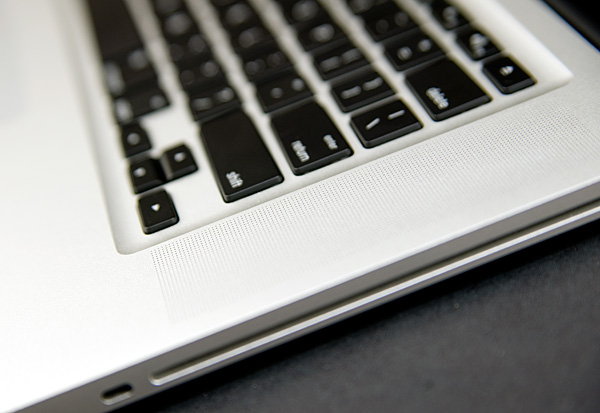Apple's 15-inch Core i5 MacBook Pro: The One to Get?
by Anand Lal Shimpi on April 14, 2010 10:38 PM EST- Posted in
- Mac
- MacBook Pro
- Arrandale
- Core i5
- Laptops
Final Words
Last year's unibody MacBook Pro update didn't do much for performance, but it did wonders for battery life. The huge increase in battery capacity meant Apple's entire pro line of notebooks could be used on cross-country flights or even during a long day of meetings without needing a recharge.
If you needed a Mac laptop at the end of last year, the 2nd gen unibody MacBook Pro was great simply because of its battery life under OS X.
The new Arrandale MacBook Pro delivers the same (or better) battery life compared to last year's model but with anywhere from 0 - 50% better performance. Apple is also offering some nice options including a higher resolution screen for the 15-inch model.

If performance matters to you, this is the MacBook Pro you've been waiting for. While I don't believe owners of the previous generation unibody need to upgrade, if you've got an older notebook this is the one to get.
The new model isn't without its drawbacks however. The most obvious of which being price. At $1799, even the cheapest 15-inch MacBook Pro is very expensive. You're paying for the design, build quality and ultimately the right to use OS X. If those things don't matter to you (particularly the OS X item) then you'd be much better off with an ASUS or Dell. The only consolation here is that the 2.4GHz Core i5 is fast enough if you thought the previous generation was quick. While I'm not sure about the 2.53GHz Core i5, the i7 is definitely worth it if you plan on keeping the machine for a while. I originally stated that I didn't believe the i7 to be worth the upgrade. Since then I managed to get my hands on an i7 system and noted its greater-than-expected performance; my conclusion has been updated to reflect that. The 22% increase in total system cost comes with a 11 - 15% increase in performance in most CPU intensive applications thanks to the extra clock speed and cache. It's a shame that this sort of performance isn't available in the 13-inch model yet, although I suspect it's related to the next point:
With a Core i5 and GeForce GT 330M, the new MacBook Pro can get uncomfortably warm under use. I found that the previous generation unibody ran cooler. Intel expects to see Arrandale power consumption go down sometime after the middle of the year with a future rev of the processor. I'm guessing that's what'll be used in the inevitable Fall update to the new MacBook Pro lineup.
Apple's inclusion of auto switching between the Intel HD Graphics and NVIDIA GeForce GT 330M is nice, however I'd still like the ability to force the GT 330M off entirely when I'd like to keep my lap cooler.
For being as forward looking of a company as it is, Apple continues to drop the ball on making a good SSD standard. Intel's X25-M G2 isn't expensive, what's stopping you Apple?

If you're curious about what's next, I have two words for you: Sandy Bridge. Due out sometime in Q1 2011, Sandy Bridge looks incredible based on early performance data. No word on when we'll see it in notebooks but if you like torturing yourself, waiting for Sandy Bridge will pay off.










114 Comments
View All Comments
n0dder - Friday, April 16, 2010 - link
Would you say that the increased working temperatures in the new MacBooks prohibits its use as a real Laptop? I'm currently using a rev 2.1 MacBook (2.16GHz), and spend 3-6 hours with it in my lap every day, and while it gets too hot if I stress it, surfing the web and doing light work is fine - if the new MBP's run hotter than that, I guess that I shouldn't have waited this long, but have gone for the previous model.TIA,
Terry1 - Saturday, April 17, 2010 - link
On page 5 of Anand's review, he notes that OS10 manages the switching between imbedded graphics and the Nvidia board. No user control apparently provided. Question: what happens when you are running bootcamp with Windows 7 as second operating system? Is OS10 lurking in the background to keep this process functioning, or (my concern) does the system just default to the imbedded GPU mode?Terry1 - Saturday, April 17, 2010 - link
RE my prior post it looks like I missed this comment in the review: "Despite using a NVIDIA GPU, there's no support for Optimus under Windows 7 on the new MacBook Pro. The GeForce GT 330M is always in use there regardless of whether you use an Optimus enabled driver or the 196.21 driver that comes with the MacBook Pro." That's the way I would want it given manual control is impossible, but has this been verified by a user/tester?PubicTheHare - Sunday, April 18, 2010 - link
Anand said to wait until the next revision of Arrandale if we want cooler laptops."Next revision of..." meaning these new MBPs are Arrandale?
If they are (I'm assuming Arrandale is 32 nm), then what would the next revision bring to equate to cooler machines?
I'm disappointed in the heat issue. My Santa Rosa MBP (early 2008) runs hot as hell, especially when I watch YouTube but even if I'm not running video or flash. It bugs me.
I won't upgrade until:
1) OS X supports TRIM (so I can throw in a Crucial C300 SSD or higher capacity Intel G2)
2) USB 3.0 or Lightpeak is available on the MBP
3) The laptops run cooler with discrete graphics
I was really hoping to upgrade this time...
BillyboyPC - Tuesday, April 20, 2010 - link
These MacBooks will be perfect with more affordable SSDs and USB 3. Until then, it's still a no-go for me.R0N1 - Wednesday, April 21, 2010 - link
Great article, but at least one aspect not mentioned:All the Arrandale chips mentioned are the standard voltage M version with 35W TDP. True, this TDP also includes integrated GPU, but still: 35W is a lot for a laptop.
The 18W 640UM, 620Um & 540UM are probably "reserved" for new MacBook Air,
But it would surly be beneficial for MBP to use the 25W LV parts (current lineup lists i7 620LM & 640LM) - any chance Apple would consider using them in MBP?
After all, all the Penryn P series CPUs are medium voltage 25W TDP chips, compared to cheaper (per MHz) T series standard voltage 35W ones.
The new Arrandale revision you mentioned - is this really silicon respin supposed to trim excessive power from the standard voltage M chips, just production process improvement or merely chip binning?
Thanks.
jvin85 - Friday, May 7, 2010 - link
Anand Lal Shimpi,I didn't see any mention about the memory difference for the Geforce GT 330M. I was wondering what differences the extra 256MB makes.
I'm considering upgrading as I use an early 2008 MBP. Back then going for the better graphics card was always a big debate. I am wondering if it truly makes a difference in these models.
Thanks.
Kathi - Wednesday, August 18, 2010 - link
I am thinking about bying a 13″ because I like the size and it would be perfekt for me. But I prefer the new i5 processor. Do you think there is a chance that there will come a new 13″ with the i5 processor? Soon? I don´t want to wait too long, but it would be stupid if a new version comes out just after I bought one…xxunrealdudexx - Friday, August 20, 2010 - link
Heading off to Uni in the fall but can't decide between 13" or 15". Which should I get? I'm in the BBA program so I don't think ill be needing Photoshop/Final Cut/etc.?? And I would like it to last for the full 4 years at least. Thanks guys!juhku - Friday, September 3, 2010 - link
Great article! Thanks!Any new information about Arrandale update to get the MacBook run cooler? Is it happening and when?